This seasonal kale salad recipe is easy and versatile, using whatever fruit and nuts you have on hand while delivering all the flavour, along with Kale’s superfood status. This salad puts your garden kale to good use, maximizing nutrition, flavour, and thrift.
Kale salad celebrates its 12th season in just a few weeks. The original kale salad was a stand-in for classic Caesar salad. Chef Joshua McFadden at Franny’s Restaurant in New York couldn’t find decent lettuce in October and defiance created the original raw Kale salad. His original recipe sounds like a Caesar salad with garlic, shredded Romano cheese, and bread crumbs, with Lacinato kale standing in for the classic Romaine lettuce.
While that first Kale salad used the tender leaves of “dinosaur” kale, Italian heirloom kale, today’s grocery store “sweet kale salad” bags are mixtures of tougher curly kale, Brussels sprouts, and broccoli stems, with colourful radicchio, sprinkled in. Hailed as “superfood” mixes, they are dry and can be fibrous later in the season. They tend to be sweeter and more tender in October.
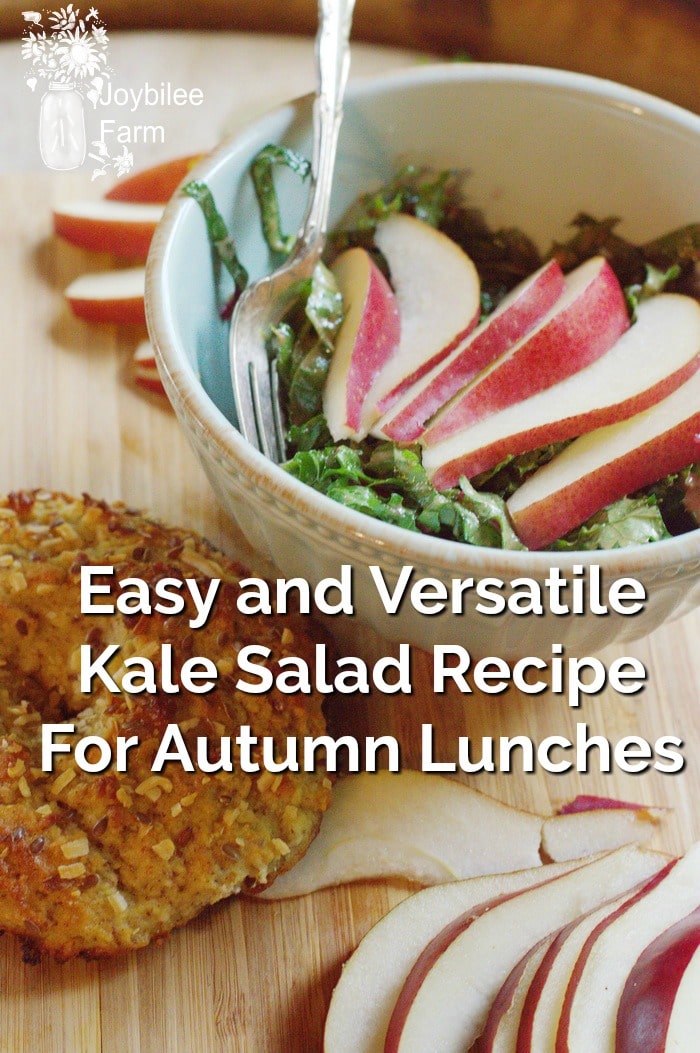
Kale salad recipes have only 4 key ingredients
The key ingredients are (1) hardy fall greens, like kale, shredded broccoli stems, savoy cabbage, sliced Brussels sprouts, or bulb fennel. Add shredded radicchio, carrots, or beets for a pop of colour. (2) Sprinkle lightly with toasted nuts or seeds for crunch and umami flavour. (3) Then add a sweet surprise like dried cranberries, figs, or dates or fresh berries. (4) Top it with a creamy vinaigrette.
The dressing is always acidic to softened the tougher greens. The addition of acids also draws the minerals and vitamins out of the tough cells, making them easier to assimilate. The stronger taste of kale pairs well with citrus flavours, like lemon, lime, or orange. Blend the dressing with good quality olive oil. Massage the dressing into the leaves or stir them in well, to bruise and tenderize them. Then leave the greens to marinate while you prepare the rest of the meal.
The flavours are earthy with umami, sour, sweet, salty, and astringent tastes represented.
The original Kale salad called for bread crumbs but, kale can stand alone. It’s gotten over its “imposter syndrome” and no longer needs to pretend it’s a Caesar salad. For crunch, I like toasted hazelnuts, pistachios, walnuts or even pepitas sprinkled in my kale salad.
When to harvest kale leaves from your garden
If you are growing Kale in your garden this is the perfect time to pick those tender top leaves and create a beautiful and nourishing Kale salad. Kale leaves get sweeter after a frost. The red varieties embolden their colours after a frost. And even after a hard frost, kale continues to produce fresh leaves until the light is too dim to support new growth, in mid-winter.
When we were in Ottawa in August, the community gardens were bursting with bushy, vibrant kale and culinary herbs. The peppers, eggplants, and tomatoes looked spindly and worn, but the kale was just coming into its own. Even container gardens on the sidewalks were bursting with kale leaves and herbs. It was beautiful.
Here are my zone 3 gardens I’m growing 4 varieties of kale. Lacinato kale, the dinosaur kale used in that original Kale salad back in 2007, is one of my main varieties. It is tasty as a raw green, in Kale salad, but it’s also useful braised in a stir-fry, added to soup or stew. (Baby greens – 28 days; Maturity 60 days. My seed came from Baker Creek Seeds.)
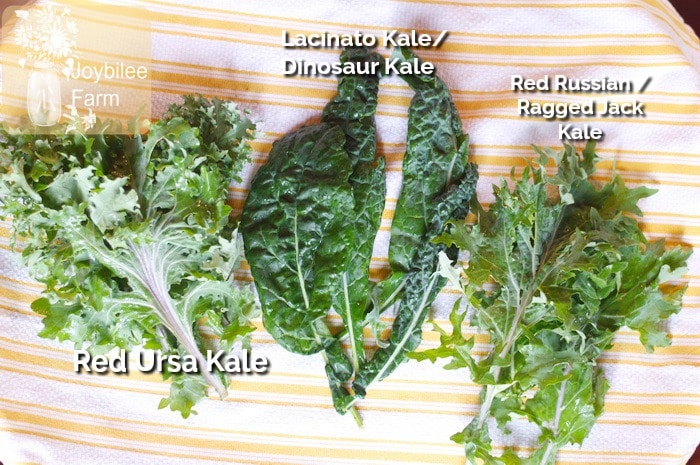
Russian Red or Ragged Jack is my earliest Kale. It’s also the hardiest and will usually overwinter here and give me seeds in the spring. It’s my favourite Kale because it stays tender even when the leaves are mature and don’t get stringy. It is an oak leafed kale with purple highlights that deepen after a frost. The young leaves are tender, while the older, lower leaves are a bit more robust and can be used in place of cabbage in recipes. After a frost, it gets sweeter and sweeter. I save my own seed with this variety. (Baby leaf production 25 days; Maturity 50 days) This heirloom can be found from most seed companies that sell heirloom seed including Johnny’s and Baker Creek.
Red Ursa Kale is red curly leaf kale that comes from red Russian and Siberian parentage. It’s an extra frilly version of Red Russian with dominant red leaf veins and stem. It can be eaten raw or cooked, like other kale, and has a tender leaf for colourful kale salads. (Matures in 65 days. My seed came from Baker Creek Seeds.)
Scarlet kale is curly kale that gets more purple as the chill of fall comes on. It’s a little tougher than the other three varieties so use it sparingly for a pop of colour in the salad rather than as the main kale for a raw kale salad. It is great as a cooked green, once the tough middle rib is removed. I found it slower growing here in zone 3, and it didn’t make the size of my other kale. But in the south, this variety is tougher and less prone to heat stress. (Baby greens 30 days; Mature 55 days. My seed came from Johnny’s Seed.)
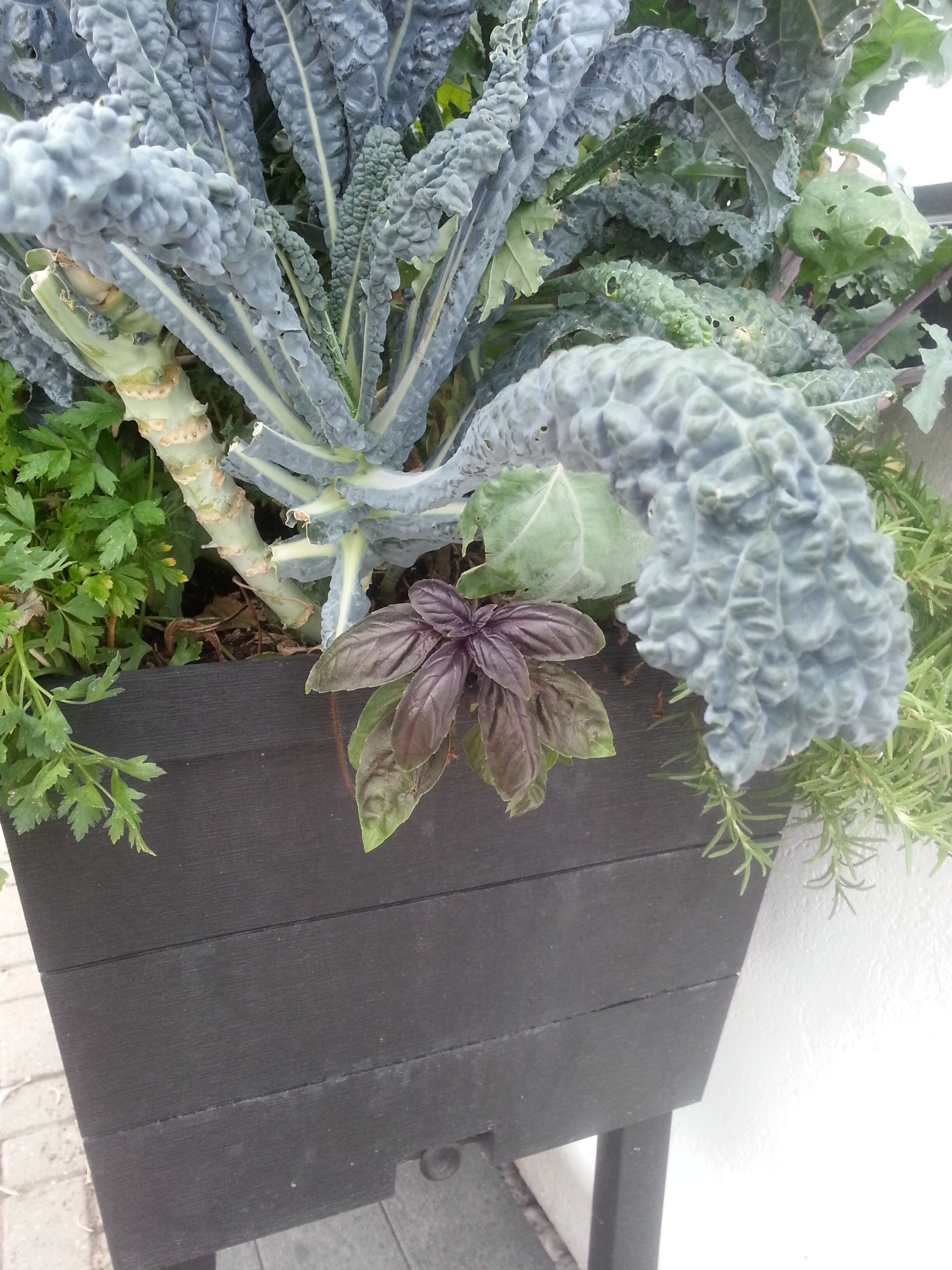
Lacinato or Dinosaur Kale, and Red Russian Kale growing in a planter along with Red Basil, cilantro, and rosemary.
If you have Kale growing in your garden, use a variety of leaf colours and textures for this salad. If you are limited to store-bought Kale, choose Lacinato or Red Russian Kale for their tender leaves.
Print
Autumn Kale Salad
- Prep Time: 20 minutes
- Cook Time: N/A
- Total Time: 0 hours
- Yield: 4 servings 1x
- Category: Salad
- Cuisine: American
Description
Use a variety of kale leaf textures and colors for this salad if you have access to garden fresh Kale.
Ingredients
- 1 Bunch of Kale or 8 to 10 leaves of garden Kale or about 8 ounces prepared Kale
- 1 medium beet, peeled and shredded
- 1 garlic clove, minced
- 1/4 cup lemon juice
- 1 teaspoon Dijon mustard
- ½ cup extra virgin olive oil
- Handful of fresh basil leaves
- ¼ cup walnuts, toasted
- 1 ripe red pear, deseeded and thinly sliced
Instructions
- Wash the kale leaves. Remove the coarse midrib and stem from each leaf. Lay the leaves on top of each other and roll them tightly, side to side. Using a sharp knife slice the leaves across the roll, into thin ribbons. Place the prepared kale in the salad bowl.
- Peel the beet and shred it on the edge of a box grater. Add the shredded beet to the kale in the bowl.
- Prepare the dressing. Peel the garlic clove and mince it. Add it to a blender jar. Add lemon juice, mustard, olive oil, and basil leaves to the blender jar. Blend until the ingredients thicken and are well blended, about 30 seconds.
- Toast the walnuts in a cast iron frying pan until lightly brown and fragrant. Toss into the bowl with the Kale and beets.
- Pour dressing over all and mix well with the salad greens. Set aside to marinate while you prepare the rest of the meal.
- Quarter and core the pear. Slice each quarter thinly.
- When you are ready to serve the salad, divide the salad into 4 individual bowls. Fan the sliced pear over the top of each salad as a garnish.
- Serve immediately.
Notes
Mix and match the herbs, fruit, and nuts in this recipe based on what you have that’s plentiful as the season progresses. This salad is very versatile.
Autumn Kale Salad
(Serves 4)
- 1 Bunch of Kale or 8 to 10 leaves of garden Kale or about 8 ounces prepared Kale
- 1 medium beet, peeled and shredded
- 1 garlic clove, minced
- 1/4 cup lemon juice
- 1 teaspoon Dijon mustard
- ½ cup extra virgin olive oil
- A handful of fresh basil leaves
- ¼ cup walnuts, toasted
- 1 ripe red pear, de-seeded and thinly sliced
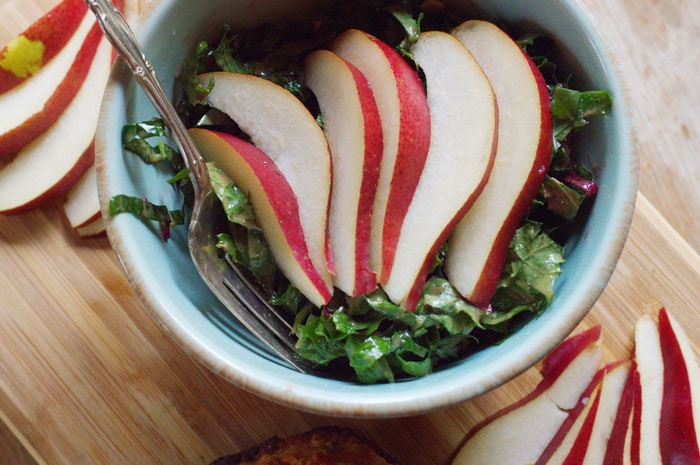
Directions:
Wash the kale leaves. Remove the coarse midrib and stem from each leaf. Lay the leaves on top of each other and roll them tightly, side to side. Using a sharp knife slice the leaves across the roll, into thin ribbons. Place the prepared kale in the salad bowl.
Peel the beet and shred it on the edge of a box grater. Add the shredded beet to the kale in the bowl.
Prepare the dressing
Peel the garlic clove and mince it. Add it to a blender jar. Add lemon juice, mustard, olive oil, and basil leaves to the blender jar. Blend until the ingredients thicken and are well blended for about 30 seconds.
Toast the walnuts in a cast-iron frying pan until lightly brown and fragrant. Toss into the bowl with the Kale and beets.
Pour dressing over and mix well with your hands to bruise the kale. Set aside to marinate while you prepare the rest of the meal.

Quarter and core the pear. Slice each quarter thinly.
When you are ready to serve the salad, divide the salad into 4 individual bowls. Fan the sliced pear over the top of each salad as a garnish.
The kale salad recipe isn’t the only thing you can make with kale. Kale is an abundant green in the garden in the Fall. Use its abundance fresh and cooked all season long. It will hold in the garden even after frost until the snow is too deep to harvest it from the garden.
So you can make this kale salad recipe from garden-fresh kale, well into December. It might regrow in Spring, offering you tender broccoli-type florets before it flowers and produces seed.
If you have an overabundance, Kale can be frozen in zip lock bags and used in smoothies, soup, stew, and other dishes all winter long. Kale can also be dried and added to soup, stew, and other dishes. See the directions to dry kale here.
All varieties of kale make delicious Kale chips which can be crisped in the oven or the dehydrator. Change the flavour just by changing the marinade and herbs. Try my recipes for 3 different Kale chips here.
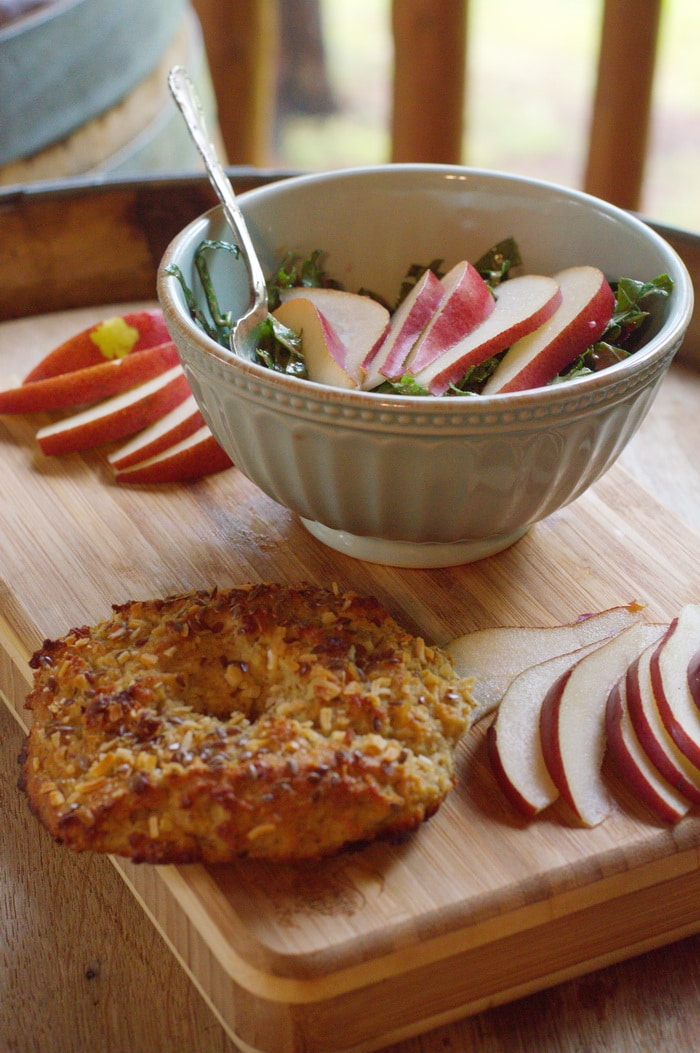
Try these other Kale salads for seasonal fresh eating
- Kale salad with Pomegranate Dressing
- Sweet Kale salad
- Hearty Greens with Goat Cheese and Lemon Dill Dressing
Use Kale instead of cabbage for a unique twist on sauerkraut



Leave a Reply